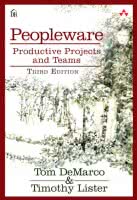Using my commute time I've just finished reading another book, this time about people and team management. And after a nice example on the web of a review including side-notes, I've decided to copy the idea and also provide some notes when worth it. I just take screenshots from the tablet or mini-notes if is a Kindle e-book, so don't expect anything fancy or detailed.
Review

Title: Peopleware: Productive Projects and Teams
Author: Tom DeMarco, Tim Lister
The review is based on the 3rd edition, which about a book that was first written at 1987 is significant.
I was recommended this book and given that I now have to manage a small development team and interact more actively with the full organization of the company I gave it high priority on my reading list. Ther results are quite satisfying, I can't but agree on so many points about how things should be done.
Issues with traditional rules, with policies, with the furniture and office disposition, with noise, with methodologies, with people... Along the 39 chapters this book is a journey about the most common things that are handled wrongly, but also about solutions, good alternatives to those problems. Combined with quite a few real world examples (sadly usually about bad scenarios), this reading feels like almost radical because of how sincerely and plainly puts some problems.
Both the good advices and the listings of things to be wary or directly fight off are pure gold, and if I had to choose something as bad, it would be really hard... maybe that the authors' humour a few times is not of my taste (but usually it is). A more than recommended read!
Notes
Elements of a healthy organization:
- Make a cult of quality
- Provide lots of satisfying closure
- Build a sense of eliteness
- Allow and encourage heterogeneity
- Preserve and protect successful teams
- Provide strategic but not tactical direction
Quick cheklist of things to fight against:
- Furniture Police
- corporate entropy
- teamcidal tendencies
- no time to add quality to the product
- Parkinson's Law
- formal Methodologies
- low E-Factor ( E-Factor = Uninterrupted hours / Body-present hours )
Management basics:
- Get the right people
- Make them happy so they don't want to leave
- Turn them loose
The purpose of a team is not goal attainment but goal alignment.
Top teamicide techniques:
- Defensive management
- Bureaucracy
- Physical separation
- Fragmentation of people's time
- Quality reduction of the product
- Phony deadlines
- Clique control
- Annual salary or merit reviews
- Management by objectives
- Praise of certain workers for extraordinary/fast accomplishment
- Awards, prizes, bonuses tied to performance
- Performance measurement in almost any form
Work to rule: Form of strike in which workers follow exactly to the rule every procedure, norm and step required for every task.
Open organization: Pushing all information to everybody instead of letting people pull for information they actually care about.
"Life is short. If you need to know everything in order to do anything, you're not going to get much done."
Unwritten (and bad) rule at work: Silence gives consent. If you don't object to things it is implied that you give your consent. This causes extra work having to make clear when you don't. Repeal this passive consent.
Need-to-know email test: Before sending any email, think about what you need for that person if really needs to know the information, or how to make him/her self-coordinate instead of depend on your emails.
Introducing changes: The introducer has all those who benefit from the old [...] as enemies, and has lukewarm defenders in all those who might benefit from the new. [...] The equation is unbalanced against change. People hate change. When we start out to change, it is never certain that we will succeed.
Naive model of how change happens:
Old status quo --better idea--> New status quo
Stair change model:
Old status quo --Foreign element--> Chaos --Transforming idea--> Practice & integration --> New status quo
Foreign element can be an outside force or the world changing.
Brainstorming facilitator ideas to restart participants' thinking:
- Analogy thinking: How does nature solve this or a similar problem?
- Inversion: How might we achieve the opposite of our goal?
- Immersion: How might you project yourself into the problem?